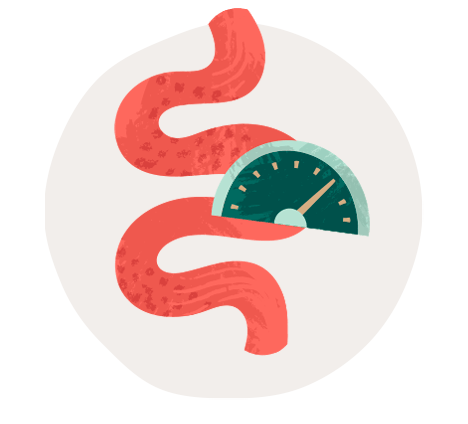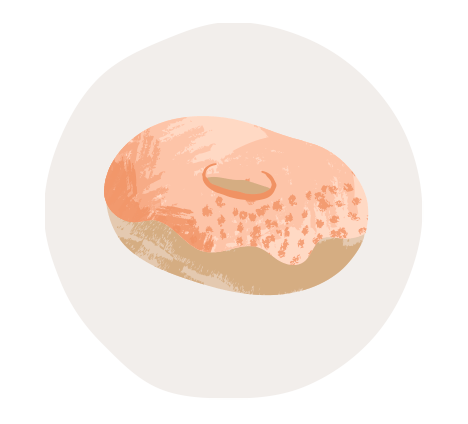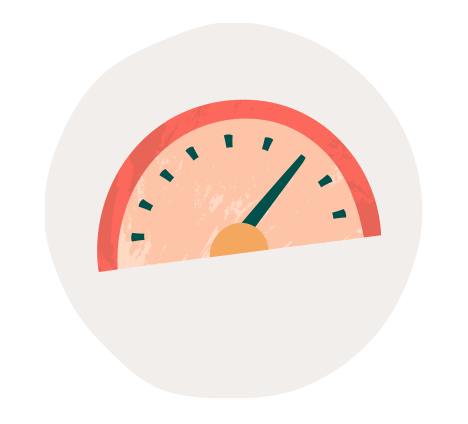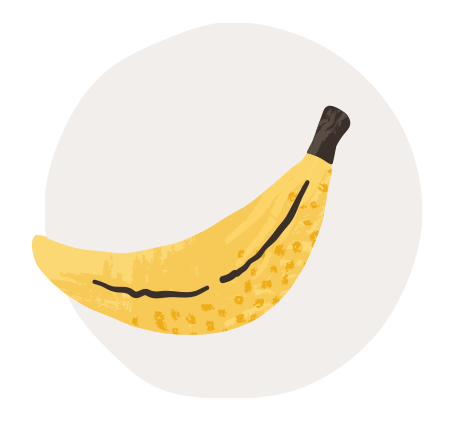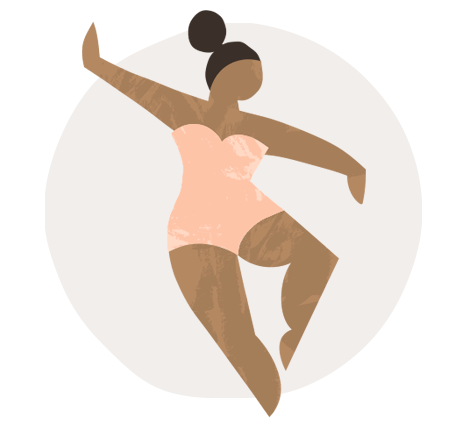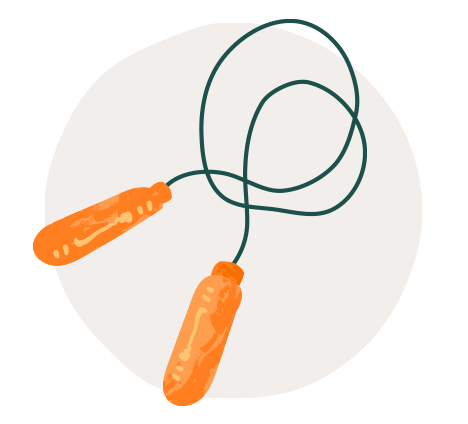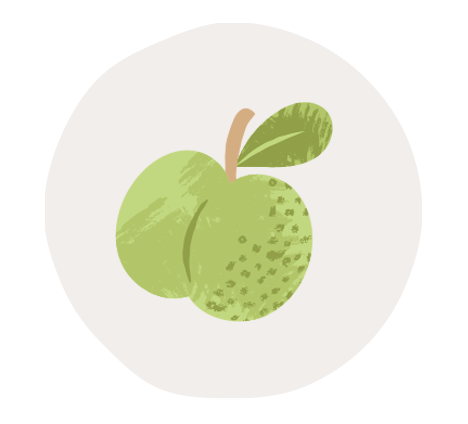Where alarm clocks don’t exist and people move to the sound of a gong
Well, I have just returned home from a 10-day Vipassana Meditation course.
I realised that it has been 7 years since I sat my first 10-day course in 2017 & that I was at the ripe old age of 21 years old at that time. I returned the following year (2018) for another 10-day course, and another again the year (2019) after that.
I have sat all courses I’ve completed so far at Pomona, Sunshine Coast’s Vipassana Meditation Centre – https://rasmi.dhamma.org/index.html
I was due to sit a 4th course in the Blue Mountains in 2020, however Covid happened and the course was cancelled.
Somehow, the years have passed since then and the practice is something that has dwindled from my life.
By ‘some good karma of a past life’, this January 2024, I found my way back to sit another 10-day course.
It has been 5 years since my most recent course, and I had absolutely forgotten how hard it was. Day 3 hit, and I thought “Monique, you absolutely did not prepare yourself for this!”
It’s funny, before I left for the course, I’d tell people where I was going, mostly to inform them that I wouldn’t have a phone for 10 days and so if people tried to contact me, there was literally no way to get in touch with me (of course a phone number is provided for the Centre in case of emergencies).
I’d just say something like “I’m heading off to a Vipassana Meditation Course and I won’t have a phone for the next 10 days so if you don’t hear back from me, I literally don’t have a way to receive or respond to messages so that’s why! Talk to you when I’m back xx”.
The responses I’d get back ranged from “Have the best time!” to “Enjoy!” to “Have fun!” to “Have a fabulous time at your yoga retreat!”
Every single person who has ever completed a Vipassana Meditation course is having a little (big) giggle.
I also got some messages of “Good luck”, “Be Happy” and “I’ll be thinking of you” from the people around me who have done a Vipassana 10-day course before.
Vipassana 10-day courses are definitely the hardest things I have ever done in my entire life. However, this was my 4th course, so don’t let the idea that it’s hard scare you away. It is also liberating coming out of a course; that’s why people go back; that’s why people continue to strive to make the practice a part of their daily lives.
After all, the technique of Vipassana Meditation is all about…
“The only conversion involved in Vipassana is from misery to happiness, from bondage to liberation.” – SN Goenka
“The technique of Vipassana meditation is a practical way to achieve peace of mind and live a happy, productive life. It is learned by attending a 10-day residential course with a qualified teacher where the student is free from distractions so that the reality within can be observed. This technique helps practitioners come out of suffering; it is non-sectarian and is suitable to all people regardless of religion, gender, race or nationality.” Excerpt taken from: https://rasmi.dhamma.org/vipassana.html
An important disclaimer
Vipassana Meditation is a technique that is about being with, and in the body.
If you have active trauma that permits this or it’s unsafe to do so, I’d recommend speaking to a trusted Health Professional or Support Source before considering.
You can also call the Vipassana Centre you are looking at, and speak with someone there about your situation, and they will either provide some guidance or direct you to someone to speak with.
I’ve known people who have attended Vipassana with multiple mental health diagnosis and they have been okay and felt the benefits of Vipassana meditation.
However, for others, dependent on situation, life circumstance, and current diagnosis’, there is always a risk when it comes to the nature of meditation itself; being present; being “with” and “in” the body.
There is a seclusion aspect of a Vipassana 10-day course. You truly are in your own world; removed from any forms of outlets, distractions or avoidance (which are actually helpful elements for someone who might be at risk for safety when these things are not available).
You can ultimately leave the course at any time, however Goenka and the course discusses that leaving a course can be hard so having a commitment to staying for the entirety of the course is a good place to commence a course. However, of course, ultimately, people leave. Generally, each course I’ve sat, about ~5 people leave throughout the duration of the course, some on days 2 or 3, some on days 5 or 6, some on days 7 or 8. You always have free will and you are not locked in to anything.
I am a Mental Health Professional and I am aware that people with multiple mental health diagnosis’, whether past or present, may be reading this blog.
This blog is a recap of my PERSONAL experience, as Monique Jephcote, NOT as a Professional. That is not the purpose of this blog. The purpose of this blog is for me to express and reflect personally as I love to do and derive great fulfilment from doing.
This is not a recommendation to partake in a Vipassana course.
Meditation is not a substitute for medical care, medication, therapy or any forms of psychiatric treatment.
Being someone who has worked in the eating disorder space, it is important to note that the food provided at a standard isn’t regular. While there are 3 meals a day provided, new students get only fruit for dinner + milk/tea/coffee.
People who have specific medical conditions, like that of a history of an eating disorder or vulnerabilities associated with an acute level of lack of adequate nutrition, conditions like diabetes, or other, or those who are pregnant, will have a proper dinner prepared for them, so if you find yourself in a category such as this, then discuss it with the course Centre and they will provide accordingly for you.
I would not recommend a Vipassana 10-day course to anyone with an active eating disorder or anyone who isn’t able to appropriately feed themselves adequately in a self-serve type basis/advocate for themselves to have a proper dinner prepared for them as opposed to fruit etc.
Speak to your individual Health Professional Team or local Vipassana Centre for more information & follow the guidance you receive there.
So, you know absolutely nothing about Vipassana or the Centres, so what do the logistics look like and what does a day look like?
Vipassana Meditation Centres exist literally all over the world.
Every single Vipassana Centre is run completely off donations.
The course doesn’t cost any money; it is free, however donating Dana (money) where you can is thoroughly appreciated. It’s what helps the Centres continue running and allows for more and more people to experience the liberation from Vipassana Meditation. Donating time and services is helpful also (the courses always need servers; people who cook and prepare your food for you, people who clean and maintain the facilities while courses run and also while they don’t, and people with skills such as building, construction, electrical to build the Centres or extensions of the Centres or accommodation buildings so more and more people can come and experience Vipassana). (If someone is charging something for Vipassana; it is not Vipassana; it is something else).
You are given all of your meals; cooked and prepared for by the servers donating their time to serve on the course for you.
You literally live the life of a monk for 10-days, where everything is provided to you by other people so you can focus entirely in on your meditation and observing the reality within.
The food (at Pomona, Sunshine Coast – as this is the only Centre I’ve completed courses at so I’m not sure about other Centres – https://rasmi.dhamma.org/index.html – ) is incredible. Honestly it is some of the best food I’ve ever had! Though Centres over the world would exist on a spectrum in terms of what they can provide in terms of food and accommodation standards because it would be dependent on the donations that are given to what can be provided.
In terms of accommodation, if you’re a new student (new student being someone who is sitting a 10-day course for the first time), you are in a shared room with a wall or curtain down the centre of the room separating you from the other person for privacy and to allow you to be less distracted. For shared rooms, there is a shared toilet and shower block close to the accommodation blocks. If you have a specific condition or if you are an older person, you generally get your own room with a shower and toilet in it.
Old students (old student being someone who has completed at least one 10-day course already) generally get their own rooms however it can be dependent on course numbers and if a course is full, you’ll need to share. For example, my first course I shared a room. My second course, I had my own room. And my 3rd and 4th courses I shared a room as these courses were full in terms of numbers.
A loud gong wakes you up in the morning and also signals timing notifications like that of the meditation starts, breakfast, lunch, tea, etc.
You don’t have a phone; you hand it in at the start of the course.
The 10 days is about leaving everything from the outside world behind and eradicating external/outside stimulation to move inside and limit any distractions from that.
You can have a little alarm clock or a basic (non-digital) watch to keep track of time however I just let my body and mind move to the sounds of the gong while at Vipassana. How often do we get that?
You don’t take books to read or journals to write in. In fact, the instructions are clear not to bring anything except your clothes, your toiletries, blankets for bedding, and ummm, that might be it? Things like a torch, umbrella, etc.
You spend 10 days in noble silence. You don’t speak with your fellow meditators, and observing noble silence also means not making eye contact (where possible; of course this happens unintentionally!), not making gestures; just moving wholly and solely into your own world in order to achieve mental silence. I hear lots of people say when they are first starting a course, that they feel this will be the hardest part. Even when I did my first course, I thought this truly would be the hardest part, walking around with ~30-50 other people each day and not speaking with them. But for me (& I think for many when you’ve done it), this is one of the easier parts. The hardest part for me is definitely the long days and time dedications to meditating and the meditating itself and being in your own inner world for 10 days with no distractions.
While I won’t go into the actual structure for the day in terms of meditation sittings, in general you meditate for around ~10 hours each day. However, these 10 hours are broken up and are never in a full stretch of time in a row. You have breakfast, lunch, and tea breaks with a longer 2-hour break over lunch time to walk the grounds of the beautiful Centre, watch the kangaroos and the baby joeys jump from their mothers’ pouches, listen to the sounds of the water pond trickling, do your washing, shower, have a rest etc. There are meditation sits that are compulsory to be in the meditation hall (3 x 1hr sits each day) and there are meditation sits where you can meditate in either the meditation hall or in your own room or in your individual cell if you’re an old student. The meditation hall is where everyone comes together to sit and meditate, both males and females. It’s a pretty wonderful feeling when everyone is sitting in there all together for the 3 x 1hr compulsory sits each day. If you’re an old student, you also generally get an individual cell where you can meditate during the meditation sits where it’s not compulsory to be in the meditation hall.
Vipassana is not the kind of meditation where you lay down on a comfy mat on the floor and are taken through a guided meditation and you ‘relax’.
Vipassana is work. You’re sitting upright, never laying down.
Vipassana is not about visuals or counting breaths or rituals.
Vipassana is not to do with any sect or religion or any spiritual belief. It does not imagine this particular god or this particular goddess and it does not pray to anything or anyone.
It is directly about you and your experience; the reality of the present moment, observing your body’s sensations in the present moment “as it is” “not as you’d like it to be”. Your body and your mind are your tools for this.
It isn’t about visualisations, it isn’t about counting breaths or altering breaths. It isn’t about going into the future or going back to the past (intentionally anyway; of course unintentionally our minds take us to the past and to the future and it gets distracted from the technique of Vipassana when doing this; I’ll expand on this soon). It’s about the present moment. Observing your body’s sensations – as it is – right now, in this moment, as it occurs naturally. Your breath right now as it occurs naturally (not changing it). Your body’s sensations as they occur right now (not wishing for this particular sensation to arise or stay (maybe a pleasant sensation) or this particular sensation to go away (maybe an unpleasant sensation; like pain). But just observing “as it is”, without craving a sensation to come/stay and without having an aversion to another sensation/wishing it would go away – thus, achieving equanimity to all sensations and observation of the present sensations within the body.
The two premises to Vipassana Meditation as my understanding is:
AWARENESS AND EQUANMITY.
Awareness of the body sensations.
And equanimity to whatever sensations arise.
Knowing and understanding deeply, at the experiential level, that everything is ‘Annica’; impermanent. Everything arises, simply to pass away again. Everything is impermanent.
I’m not going to go into the technique of Vipassana in this blog because I’m not at all qualified to do that and it would be inappropriate. That is what the teachers are for.
My only notion to you would be; if you’re curious, do it. And you can learn the technique yourself, and decide for yourself if it’s something to pick up in your life or leave. Please be sure to read the important disclaimer at the start of this blog.
Goenka talks about how Vipassana is not a sect, not a religion, not a spiritual belief. And how people can often have a hard time with this, particularly if they are a part of a sect, or religion, or spiritual belief.
However, Vipassana is Universal.
Goenka just asks you put those things aside, just for 10 days, just 10 days, to give a real commitment to learning the technique of Vipassana meditation, and after those 10 days, you decide what is best for you. Time and time again what I hear from him is that Vipassana is truly Universal; meaning anyone, anyone, from any religious background, any sect, any spiritual belief, can practice Vipassana because it has nothing to do with sects, religion or spiritual beliefs. Its only tool is YOU. Your BODY. Your MIND. “You are the only one who can bring you out of bondage” “You are the only one who can figure out your own salvation”.
If you want to read more about Goenka, you can head here: https://www.dhamma.org/en/about/goenka
The courses are taught by Mr. S.N. Goenka, as taught by Sayagi U Ba Khin. His instructions are played on audiotapes throughout the days. And there are discourses (about ~1.5 hours long) at night where you watch video tapes of Goenka speaking you through the theory of the practical/experiential aspects of what you are implementing during the day in your meditation sits. While the courses are therefore taught on these audio taped instructions from Goenka and played for you to follow, there are also 2 assistant teachers (1 male, 1 female) who sit up the front of the meditation hall who meditate with you, and you can ask your teacher questions during the lunch break if you are having difficulty or trouble with learning the technique of Vipassana meditation. There is a manager for the course who you can turn to for any material questions at any time during the course.
So…. You meditate for 10 hours a day! You can see now, there isn’t really much room for anything else. You’re working hard on the technique. There isn’t time to read a book, or journal, or get back to people on your phone. So not only would all of these things be distractions from you really being able to move into your own inner world to give the learning of the technique a fair trial, but you also… don’t have time!
Ok, that’s the logistics covered. Now let’s get in to me recapping personally what I learnt throughout my 4th course of Vipassana Meditation.
Reflecting on all 4 courses
This course felt different for me.
Going into it, I had a deep inner feeling that I needed to be there. This was similar to the feeling I had before the first course I ever did.
The past 5 years since my 3rd course (my most recent course since this one) have been big years for me.
I opened a private practice.
I closed a private practice.
I’ve sat with people in the depths of their pain; hearing their stories.
I’ve held a lot of space to support people; meeting them where they are at. While I’m not a therapist, I’ve co-facilitated mental health groups and eating disorder groups with therapists and I’ve been able to witness the power of helping people sit with their feelings rather than try to change them; acknowledge the presence of emotions rather than get mad at oneself for having them or frustrated and impatient for them to change.
Helping people to understand they are not broken; and how to ‘observe’ and ‘be curious’.
In turn, helping people with all of these things, has inevitably helped me with all of these things. As a by-product. I’ve come a long way within myself across this time.
If you’ve done a Vipassana course, you are likely nodding along with my following statement that I deeply feel the past 5 years of this ‘work’ in my working life has allowed me to deepen into the philosophy of Vipassana; in a way that while I haven’t necessarily been practising Vipassana Meditation, has allowed me to step back into the practice of Vipassana this year with a new found understanding of what the actual technique of Vipassana Meditation is all about.
This course for me, I felt like, for the first time, I understood the technique of Vipassana Meditation. Despite having completed 3 courses prior; younger Monique never understood.
It felt like I was hearing a lot of things for the first time; understanding a lot of things for the first time.
Vipassana is about observation; not developing attachment to particular sensations (wanting them) and not developing aversions to particular sensations (not wanting them).
At the depth of it all, feelings occur as sensations in our bodies.
Someone says something to us, abuses us, shouts harshness at us, and at a deep level within, a sensation in our body arises. That continues to roll and roll and roll through life at a sub-conscious level; we continue to react in ways that the habit pattern of our mind has reacted or responded with in the past and that of which has been strengthened over time and responses/reactions.
Vipassana is a meditation that works directly at this experiential level, with these sensations. Using your own body, the sensations that arise, in the present moment, to work to not react to the sensations that arise, whether a blissful tingling sensation throughout the whole body, or whether deep surging pain down your hips; you eventually learn to observe it “as it is”, the tingling or the pain, observing it without attachment, knowing it is impermanent. As Goenka says “keep working with the technique, and the law of nature will take care of the rest”.
I’ve never come across any other technique that works directly at the experiential level.
You don’t go to the past; you don’t go to the future. You just utilise, observe, what is happening with your current body’s sensations in the present moment and work to achieve equanimity through not reacting to the sensations; just observing them “as it is” “not as you’d like it to be”.
“The law of nature will take care of the rest”.
It really does work, but I’ll let you be the decider of that for yourself.
Coming back to reflecting on all 4 courses, and the past 5 years since my last….
I’ve also spent a lot of time with my own miseries these past 5 years; I’ve spent time going all the way back to reclaim the parts of my younger self that I left behind, allow them to feel safe and to bring them forward as I move into this next chapter of my story…
I was 21 years old when I completed my first course.
Then I was 22.
Then I was 23.
My 4th course, being the one I just completed, I’m almost 29. There’s a lot of life for me left to live and my learnings have only just begun but I feel that I’ve had a lot of experiences of life since my 1st Vipassana course at 21 in 2017, and I was able to bring the learnings, growth and maturity of my current day self into this course compared to my first.
I believe 21, 22 and 23 year old Monique was doing the ground work for 28 year old Monique to arrive at this Vipassana course in 2024; truly.
This was a BIG course for me.
I needed to be able to somewhat pick up the technique easily at this age and in this course. And having done 3 courses before, even if it was some time ago, I was able to understand the technique at a deeper level and pick up (somewhat) where I left off, with all the life that has happened in between.
I feel that the 1st course I did was about learning the technique; kind of skimming across at a surface level the waters that lie beneath, skipping over them almost because there was a lot of concentration required; hearing the instructions for the first time; practising for the first time, the routine/s of the day for the first time; being away from my partner for the first time etc. Looking back and reflecting, the 1st course felt very much so about learning the technique itself. I don’t remember being distracted by my mind all too much; whether it was because I was so entrenched in learning the technique or that there wasn’t a whole heap of misery going on outside in life. It was an incredibly hard 10 days, as my system had never experienced anything like it. Though, I will never forget how I felt coming out of my first ever Vipassana course; it is like a feeling like no other. I felt liberated.
My second course, was so far still, the hardest course I have ever sat. My mind felt like my enemy. I was constantly distracted by deep feelings and thoughts and memories of anger and rage. Goenka talks about “Sankharas” (my understanding is that these are our automatic tendencies, auto-response patterns, habits where our deep knots are stored in the body as a sort of memory created in the past from resisting the reality of our sensations). Goenka speaks of practicing Vipassana so as to ‘clear away the old stock of sankhara’ and then train the mind to be equanimous, so that ‘new sankhara is not generated’ when we face the ups-and-downs of daily life. When all the sankhara has been cleared away, one’s mind becomes clear and free from suffering.
Well… my 2nd course was the course for sankharas alright. I could not escape these distractions of my mind. I found it incredibly difficult to come back to the technique of Vipassana meditation. I would sit and boil in the feelings, situations of things from the past and anticipation or worry for things for the future etc. Vipassana, as I said previously, is not about going back to the past or thinking about the future; it’s about the present moment. However, when our minds have 10 hours a day of sitting, everyone will inevitably find the mind will unintentionally go to these places at times. However, just to be clear, the practice of Vipassana itself is about the present moment and bringing your mind back to the present moment when it becomes distracted by past or future. However, I really struggled to do this in my second course. My mind was constantly somewhere else and it was very distracted by very challenging thoughts and feelings. What I can come to understand now (something I learnt in my 4th course from the teacher that has it’s own section coming up!) is that, I don’t believe I was meditating during my 2nd course. Maybe a bit here and there, but mostly, I wasn’t meditating. I didn’t ask the teacher for help when I was struggling with this distracted mind in my 2nd course. I was 22 and I think at that time I still held this notion within me of being embarrassed for not being able to “do it” or “do it right”. I remember thinking “this is my 2nd course, what will the teacher think of me to know I’m struggling so much with this rage and anger that I can’t even get my mind concentrated enough to feel my body’s sensations!”.
Fast forward to today, and I’m glad that’s not a part of my inner world anymore because I finally got some help around this question during my 4th course. Reflecting back on my 2nd course, I think I either needed 1 of 2 things, 1. to have reached out to the teacher and asked her for help and guidance with the things I was struggling with during that course and to get help so I could move forward with the technique & get back to meditating in the sits; I would have also heard that what I was experiencing was incredibly normal, and everyone struggles with the exact same thing I was struggling with; I absolutely was not alone in it even though I felt I was. This would have helped. I also think what I needed at that time was 2. therapy; some external support. Being with my own inner world during that time was too hard. There was a lot going on in my life, really high emotive experiences and situations and what I needed was some psychological unpacking and processing and support (which I got!). So, my second course it felt like I sat in a lot of very challenging emotions for 10 days; thinking of the past and anticipating the future surrounding these situations. Later I’d learn this is not meditating. It’s something else. I’m getting to this soon! This also had hard consequences for me, as not long after the course, a huge emotional explosion occurred in my life; a huge reaction and things were really difficult situationally for a long time. This course was hard, but looking back, it absolutely had its learnings for me. Sometimes things happen and years later we realise exactly why it had to happen that way.
My 3rd course, despite how hard the 2nd was, I still found my way back the next year to do another course. There’d been a lot of sorting through of things and I could come back into my 3rd course and delve into the technique again, learning more and understanding and growing in the technique more. However, my 3rd course was distracting for a different reason. My partner was doing the course with me! I was so excited and ecstatic he was doing it, experiencing Vipassana Meditation! I was constantly wondering how he was going; and this was distracting at times for me from my own inner world of delving into the technique. Nevertheless, it felt special to complete a course together.
My partner and I have always had different interests, different things we like doing, as well as things we both hold interest in and the same things we like doing. We both feel this is important. To have our own things that the other doesn’t have to have or do. My partner is the type of person that would never do something like Vipassana if he’d heard about it. It would be the thing I go off and do while he stays home and plays golf and runs marathons. However, the fact he did a course means a lot to me. Vipassana meditation I feel is going to be a part of my life forever and there is something quite special about sharing your experiences after a course and calling or speaking with someone who you know has done a course. There’s a lot of background fluff you don’t have to sort through. You know they just ‘get it’. They’ve done it! It feels really special and important to me that my life partner has done a course, because I have a feeling I’ll be implementing Vipassana meditation into my daily life from here and attending many courses across my life. To reflect with him in a way where he understands even having just done the 1 course, is wonderful. Prior to him doing a course, he thought for sure Vipassana was a cult 😂 Him coming out of a course, he felt a deep appreciation to the fact that it is specifically outlined that it is not a part of any sect, religion, belief, dogma, rite or ritual. It just uses YOU as your own tool. And I think he feels comfortable when I go off to courses now; he knows what I’m doing every day.
My 4th course; this course… Well, more to come below. But following on from the former paragraph about sharing your experiences after a Vipassana course with people who have done it, my 4th course felt special for this reason because it was the first course I had completed where I had a plethora of people around me who had done courses across the time since my most recent course prior to this. My partner had done a course so I could come home and talk to him so freely about my experiences. My Mum had done a course so I spoke with her for an hour and a half on the phone. My sister had done a course. My best friend had done a course. My best friend’s sister had done a course (multiple, served, managed etc!). There was something special about this course (for many, many reasons) however 1 of them was that a large handful of people in my life have done courses since my most recent one prior to this. I had people to talk to, reflect with, who truly ‘got it’.
I believe younger Monique was doing the groundwork for current day Monique to arrive at the hands of Vipassana yet again. After all, every course holds something for you; more unravelling; more to understand, to “know thyself, know thyself, know thyself”.
I understand!
I had a lot of moments throughout this course where I truly felt as though I was hearing things for the first time and understanding things for the first time.
Perhaps the 7 years since my first course, the 5-year lapse since my most recent course, and a lot of life in between; did me good.
Goenka warns time and time again about the importance of working “properly”.
You can work hard; absolutely, every day you can work “hard”.
But the importance of working “properly” and “understanding” the technique; he discusses time and time again.
I remember sitting in past courses, and those words never really hit anywhere.
This time, they did.
In the first 3 days of this course, where natural respiration is observed (Vipassana is not taught until day 4), I, for the first time, observed my natural breath. Without changing it; and having long periods of time without distraction or my mind wandering. Truly, being “with” it; and feeling the small area of sensations that is first outlined in the first 3 days prior to the teaching of Vipassana on day 4. I remember thinking, “Oh wow, it really IS about observing it AS IT IS” (I mean, how many times Goenka “says” this, but we all have our “moments” throughout, maybe over many years, of truly understanding and feeling it; and this was 1 of those courses for me with many of these moments).
On day 4, you are taught the technique of Vipassana Meditation. And this is about observing the sensations all over the body, without craving or aversion, working to build an equanimous mind to all the sensations. Again, whether that’s pleasant sensations or unpleasant sensations. Most of us just have to sit in the 1 position, upright, for a few minutes to experience discomfort and pain. Imagine that for 10 hours/day! You’re going to feel pain and discomfort. The idea is to work with the technique to reach a point or various points throughout (because you certainly bounce between holding equanimity and not at all holding equanimity; it’s not a linear path), but the idea is to exist in a place where you are simply observing this pain (perhaps it’s a burning sensation in your right hip – hello me!), observing the pain, without aversion to it; without reacting, observing it “as it is” with curiosity and awareness, “as it is”, “not as you’d like it to be”.
This was the first course that I have ever experienced equanimity to pain. Absolutely, it bounced around. Some sits I could observe it without reacting. Other sits, I’d react “Oh F**K, when will this meditation sit end and GOD I can’t handle this pain anymore”. But I absolutely experienced a significant handful of sits where I could sit for 1 hour, without moving an inch, and truly observing the pain areas, “where is this pain starting, where is it most intense, where does it fizzle out”; observing it with awareness, without aversion, without wishing it would go away; knowing deeply – it is impermanent. Or there would be a tickle come across my face or anywhere on my body, and your instant reaction is to itch it, to get rid of the tickle because it’s so unpleasant. You observe the tickle, equanimously, and observe it fizzle away without you having to move an inch.
So, the big, unpleasant sensations work at the experiential bodily level on the concept of “aversions” and not reacting to these sensations with aversion.
The smaller, pleasant sensations like perhaps a light tingling sensation or other, work at the experiential bodily level on the concept of “cravings” and not reacting to these sensations with craving.
We constantly live lives in connection with these concepts of aversions and cravings. We crave certain feelings, situations, experiences. We react when we don’t get those things. We react in big ways, for years and years.
We hold aversions to certain feelings, situations, experiences, and we react when those things are in place in our life. Again, in big ways, for years and years and years.
And this results in a lot of misery, a lot of suffering.
When the thing we’re craving doesn’t show up – we feel misery.
When the thing we’re averting shows up – we feel misery.
The idea is working with the body at this deeper level, using the sensations of our bodies in the present moment to become equanimous; less reactive, to the sensations occurring/arising within the body. And as Goenka says, which truly happens, “Keep practising, and the law of nature will take care of the rest”.
Sometimes, seemingly without having to understand everything, without having to process everything, without having to know all the theory in the world, sometimes, the practise of Vipassana seemingly allows you to arrive in a place where you are not reacting as you would have in the past. And it’s not that anyone else has changed. It’s not that that person has changed the way they speak to you that triggers you, they are still the same, but YOU have changed. Your inner world has changed.
The ‘law of nature’ has taken ‘care of the rest’.
This concept hit home for me; I finally understood it because I had a moment of feeling it.
I have always known that, as adults, we are truly 100% responsible for our own selves, our own reactions. And that your neighbour holds 0% responsibility for your own self, your reactions. But, we all (as humans) walk around feeling (perhaps subconsciously) as though other people hold SOME level of responsibility for the way we feel; for the way we react. Like “maybe if they just changed even a little bit; if they didn’t shout that abuse at me; if they didn’t do that thing that hurt me so much, if they just changed a little bit!”. We get attached to this thought process. The habit pattern of our minds. “What mad minds we live in”. What a human experience we signed up for huh! How distracted our minds become from our own inner worlds by looking at and thinking that the issues and misery exist outside of ourselves.
And the thought comes… “alright, maybe we are responsible, but maybe it’s 50% them and what they said/did to me/how they are/how they act, and maybe it’s 50% me and my reaction. Yep, that’s it!”.
Vipassana teaches you, not through process work, or theory, but through the direct experiential experience with your body, at the present moment, from moment to moment, working with your sensations, working with equanimity, that truly, we are 100% responsible for our own selves, our own reactions.
“You have to work out your own salvation” – S.N. Goenka
I had realised that while I’ve always known and barbed this statement “we are 100% responsible for ourselves and our reactions, and others are 0% responsible for our own selves and our reactions”; the living part of me wasn’t living this. Holding onto past hurts, holding on to things people have said and done, “oh, how they hurt me!!!!”. Roll it over, again and again and again (we all do). I realised in one moment of meditation, deep in tears, that this is how I avoid life itself. “This is how I stay distracted from life”, “this is how I stay stuck in my own misery”. I think on some level this is how we all avoid life. Stuck in this rolling.
Vipassana helps to reclaim that responsibility; not through judgement or indictment, like I see things and people doing with this concept at times, but through Hope, and something that nothing else has ever quite given me: experiential understanding.
Compassion, Hope, Understanding.
Vipassana holds huge moments in ways that hit you like nothing else does. I’ve spent the last 15 years in therapy; on and off. I first sat in a therapist’s office at 13 years old on the back of a diagnosis of depression and anxiety. Feelings that have stayed with me and re-ignited at various points throughout my life. I’ve spent a lot of time in process work, in understanding myself, my reactions, more and more and more. I’ve worked really hard. And I’m eternally grateful for my parents for introducing me to the concept of therapy at such a young age when they could see I was having a hard time and needed support that just wasn’t possible to be provided by anyone or anything else. I’m not quite sure who I would be today without that. I value therapy so deeply; most people who know me, know this. Therapy will always be a part of my life. Though there is something that occurs for me during Vipassana courses which is beyond expansive; like its earth shattering and life altering. It’s not just these ‘knowing’s’; these ‘theories’ that I can understand and compute and re-iterate or remind myself of in moments when needed. It’s these deep experiential moments of “oh my f**king god… there….it….is”.
Vipassana is an ‘experiential’ teaching and learning; your body is your tool. It’s not an intellectual game. Certainly, the discourses at night where Goenka talks you through the intellect and the theory behind what you’re doing helps you to understand why the heck you’re doing what you’re doing each day, and this helps to click pieces of the puzzle into place. But these discourses, without the practical application of Vipassana, wouldn’t have the same impact.
Every single day, every single moment, our bodies hold sensations. Right now, multitudes and multitudes of sensations are pulsing through your body. We live our lives without an awareness or active feeling to these sensations because we are so “here, there, everywhere”.
Vipassana is about becoming quiet enough to feel these sensations, and as I’ve written in the blog I wrote after my very first course, (which you can find here – https://centreforintuitiveeating.com.au/vipassana-meditation-course-reflection-19th-february-2017/ – a mind-blowing moment for me was experiencing the reality of my body vibrating. They say we are vibrational beings. In my first course I felt this for the first time. I understand that some people experience these moments the first time they sit a Vipassana course. For example, when I was reflecting this realisation with my partner yesterday, he said that he experienced that in his first course. For me, it took a few courses.
We’re all different.
You’re not meditating!
If you’re still here reading – congrats! And let’s take a brief recap back to where I discussed that during my second course, I spent so much time stewing in anger and rage and fast forward to my 4th course, I understand that this isn’t & wasn’t actually meditating.
So, here I was, 4th course. And some anger had arisen. Some pretty significant anger. Anger that was taking me away from the concentration of my mind; distracting me from being able to practise Vipassana meditation properly and feel my body’s sensations. It was so distracted by these thoughts, memories, feelings. I’d keep trying to re-centre, to come back to the breath initially as a concentration tool and then when calm enough, move back into Vipassana (feeling the body’s sensations). But nothing was helping. I’d come to breath, breathe harder if need be, still, in 10 seconds, my mind would be gone back to these places, and it would stay there for 5 minutes, 10 minutes, 15 minutes, 20 minutes, before it’d come back. Sometimes, I’d recognise it going “I am aware that my mind is wandering off to these situations, and heck, I’m choosing to go along with it!!”. I’d feel aware of it going, and I’d willingly follow it there. I spent maybe 1-1.5 days in this place. Constantly trying.
I decided to have an interview with the teacher and I told her all of the above.
And she laughed (with love and compassion as those liberated Vipassana meditation teachers do!) and she said “ahh ok, so you’re not meditating”.
Sorry, what?
I thought “what the f**k do you mean I’m not meditating, I’m sitting for 10 hours a day in silence, “with my breath” “with my sensations” “with my body” “with my mind”. I’m sitting here. I ain’t sleeping! Of course I’m meditating!!!!!!” (I didn’t say that, but I thought it!).
She said something along these lines: “Meditation is about being in the present moment. You say you are thinking of the past and the pains there rolling over and over, and you are also thinking about upcoming moments in the future and making predictions and anticipations about how they will go or worries about that, so this isn’t meditation when you are in those moments; as they are not about being in the present; the present moment. Meditation is about the present moment”.
Writing that and reading that back I’m like “Duh, of course meditation is about being in the present moment”.
However, things really clicked into place for me; particularly in regard to some of my past courses, specifically my second course where I spent so much time NOT in the present moment. I wonder if I had of heard that piece of advice back then. And this is how I managed to reflect previously that I don’t believe I was meditating in my 2nd course. Sure, here and there. And sure, I sat in the meditation sits for 10 hours/day for 10 days. But as Goenka warns time and time again the importance of working “properly”; I was not working properly…. I finally understood this.
She continued to share something along these lines: “We’re not in meditation when we are thinking about the past or the future; that’s something else; that’s ‘thinking about the past or thinking about the future’; that’s not meditating. Vipassana Meditation is about eradicating suffering, but if you’re not doing Vipassana Meditation, if you’re not in the present moment observing the reality of the present body sensations, with equanimity, and instead you’re in the past or future; that’s not actually Vipassana and therefore will not eradicate suffering.”
She helped me with a few tools to come back to the technique.
“When you’ve noticed the mind is gone, try to bring it back to the body’s sensations at that present time (Vipassana). If you can’t, try to feel the touch of your clothes or the atmosphere around you as the sensations on the body. If you can’t do that, bring it back to observing your natural breath, and if you can’t do that, breathe slightly harder to reconcentrate the mind. Bringing it back to the natural breath and observing it as it is, or breathing harder if need be, is a tool to help concentrate the mind to make it calm enough to practice Vipassana, so doing this itself is not Vipassana. Staying with just the breath will not eradicate suffering as that’s not Vipassana meditation, however, coming back to the breath when you need to is a concentration tool to quiet the mind enough to be able to come back to Vipassana. So, try to move on from observing the natural breath when you’ve got it, and move back into observing the body sensations (Vipassana). But remember, observing this natural breath or observing harder where need be is a tool you can always come back to in your practice in order to re-concentrate the mind and let it become calm enough to then move back into Vipassana and observing the body’s sensations. Just keep going, keep starting again, and keep going and keep working with equanimity”.
After this interview with the teacher, there was a block of 3 sits that afternoon that equalled 4 hours in total. This was the most concentrated, aware, and equanimous stretch of meditation I had throughout the entire course.
I remember walking out of that 4-hour block, and specifically the 1-hour determination sit, and I walked out feeling like I was seeing the world for the first time, and I thought “I just damn well f**king meditated”. Not every sit is the same, but Vipassana is about these moments. Where you ‘get it’, but also don’t become attached to that concept as you know each sit will be different.
Hearing this concept from the teacher, I walked away and felt this deep sense of compassionate determination to work “properly”. Now that I understood that I, in fact, wasn’t working properly at times, I knew what I needed to do in order to make it so. And it’s a constant learning from here. Not a “Uh, I get it now, so that’s all sweet and sorted”. No, not at all. Even last night, my first meditation at home, I felt my mind drifting to the past and to the future, and I just compassionately observed that, allowed myself to know that’s really normal, it’s the habit pattern of my mind, and gently brought it back to the present moment, first to the breath, then when calm and concentrated enough, to the body’s sensations, and equanimity to those sensations. It’s a flow sometimes, a back-and-forth other times, an in and out other times. Equanimity is also equanimity to these moments. We observe our bodies sensations. But naturally we find ourselves observing our minds and acknowledging their own patterns too; with compassion, with understanding and knowing deeply “you are never alone in that”.
When the teacher said to me “that’s not meditation” (i.e. when thinking about past or future), it really helped me to properly label the experiences I was having. For example, finding myself thinking about the past or future for an entire sit, I would calmly acknowledge that that wasn’t meditation. That’s okay, but it helps to not walk away from it holding the understanding that “I just meditated, purely because I sat for an hour in silence despite that my mind did whatever it wanted to do and wandered to past, future and anywhere but the present”. I then wasn’t labelling something for what it wasn’t. And so, I could understand that I likely wouldn’t feel the benefit from that sit. This reminded me of how important it can be sometimes to truly understand experiences for what they are and the power of language when labelling experiences.
If I think I am meditating purely because I sit for an hour in silence with my eyes closed and in an upright position, and mind is going here, there and everywhere, then I’m likely going to walk away wondering why is it that I don’t really “feel” like I’ve just meditated (i.e. liberated). I kind of just feel pretty angry and frustrated. And I’m going to have a disconnected understanding to what meditation is.
The metaphor I thought of for this, was in my own line of work with working as a Dietitian around food behaviours; specifically, when I educate and support people with the concept of “comfort eating”.
How often people come to me “Oh Monique, I can’t stop comfort eating. I feel a particular way and then I just eat and eat and eat! I can’t stand it and I want it to stop”.
Totally valid; and often this experience is really stressful for people.
I always ask a question to understand their situation. “So, when you are eating for comfort as you describe that you are, are you feeling comforted afterward?”
They often respond straight away, “God no, I’m not. I feel guilty and full of shame”.
And I say, “So, you’re not comfort eating then”.
They look at me a little confused.
“Comfort eating actually has to bring you a sense of comfort. If you’re not feeling comforted after the eating experience, then it’s not comfort eating; it’s something else”.
Comfort eating is really normal, diet culture has demonized it, but comfort eating is normal. The minute we leave the womb, we cry as we enter this big world and we latch onto Mum’s boob and drink that milky goodness, and boom, a relationship between food and comfort is latched. It’s actually normal to derive comfort from food. There may be issues that arise for a person on an individual level when this is someone’s ONLY way to know how to comfort or soothe themselves. We all need a plethora of ways in which we know how to comfort and soothe ourselves; not just one (but still, no judgement required even if it’s someone’s only way that they know how to comfort and soothe, I always say “God I’m so glad food was there to comfort and soothe you when absolutely nothing else was”). Then we work together to find a variety of ways that bring comfort and soothing; food is still there, it’s just that other things are there too; this really helps with scarcity issues and releasing judgement.
So, I share all this, and they generally understand that and think it makes a lot of sense.
And then we go back to the concept that in order to LABEL comfort eating AS comfort eating, it has to ACTUALLY have brought COMFORT in order to appropriately use the language and label it as that.
If it hasn’t brought comfort; then it’s not comfort eating, because the very thing that was sought, wasn’t the outcome.
Comfort wasn’t felt.
So, if a person feels guilt and shame, then perhaps it was more about numbing, than about deriving comfort.
And this is a totally different thing. (Nothing requires judgement, but it helps to know what the actual experience is that’s going on and label it properly).
When we have gaps in our understanding of something, we can mislabel & this can influence our internal understanding or dialogue greatly.
When someone walks away from an experience thinking they are doing something, because they’ve used the language with their current understanding of ‘what that thing is’ or ‘what that thing means’ i.e. in regard to what they are doing, then they often feel confused when they don’t feel the way they expected or they thought they would. Becky is confused walking away from times when she thinks she’s ‘comfort eating’ and she’s not actually feeling comforted. What the heck? It’s because it’s not comfort eating. Great. Now we can continue to explore what’s really going on and get some proper support. We can stop calling it that when comfort actually isn’t in the room as a feeling after the eating experience, and we can start recognising it and acknowledging it as something else.
I thought of this as the metaphor to a way in which I could easily understand what the teacher said with regard to “you’re not meditating”. Here I am, with my current understanding of meditation (that had some gaps in understanding to it), thinking I’m meditating because I’m sitting with my eyes closed, cross legged for 1 hour. Regardless of the fact my mind is anywhere but the present moment, I think I’m meditating. I finish the sit, and I don’t really feel great. I’m still stewing over all the stuff I just explored from the past with my mind. I walk around thinking “I meditate, I meditate, I meditate”, yet, why am I still in so much misery? Because stewing in the past or worrying about the future is not actually meditation! It’s something else.
I’m now about to move forward with a deeper understanding of the technique. And I can label it appropriately to help myself continue to move forward; understanding myself more.
Take it day by day; not counting down the moments
I really took this course day by day, moment by moment. Which was very different to my past courses. In the past, I remember counting down the days. “Ok, it’s day 3, that means there is XYZ days left, and XYZ hours of meditation sittings left” and I’d find ways to somehow make it sound like there was less to go than there really was to make myself feel better.
Essentially, wishing the time away.
This course; I really took it day by day.
Some days went so fast and I couldn’t believe the day was over by the time I got into bed.
Some sits went so fast that I honestly thought “how in the heck did I just sit there for an hour meditating”.
This was all pretty new to me.
I had maybe 2-3 times total throughout the course where I might have said “oh my gosh, it’s only day 5, there’s still 5 more to go”.
And I’d fairly quickly have a compassionate moment with myself of “you can’t think like that Monique, this isn’t about wishing it away, it’s hard, but these moments are important, just take it day by day, moment by moment”.
And, so, I did.
Continuity of practise is the secret to success
This was the course for me that was about re-centring in the technique; in order to make it a part of my daily life.
And having come out of the course yesterday, I deeply feel inside that “this HAS to be a part of your daily life Monique”.
The technique of Vipassana truly brings me so much.
It’s about coming out of misery and living a happier life.
I’ll take that, thanks!
Goenka advises at the end of the course that for a minimum for someone to make it a part of their daily life, one is to practise 1 hour in the morning and 1 hour in the evening at a minimum for a year. Once that’s done, it’ll be there with a lot more ease and part of the routine. After all my previous courses, I had managed to keep this up for maybe a month at most, and inevitably, at some point, the practise fell away.
This time I am going into it more realistically, with a strong determination for 1 hour a day every day, with more of a minimum focus around “at least 3 days a week at a minimum”.
I realise there’s wriggle room I’m giving myself, but this is also because I know that for me, this path is lifelong. I won’t be completely centred in the technique with that time and practise schedule, but I’ll be on the path. I plan to go back again and attend more 10-day courses to continue centring in the technique of Vipassana Meditation and continuing to have it becoming a part of my life ongoing.
And most importantly, I feel I have a newfound understanding of what it means to practice “properly”.
So, I’ll work hard, but more than working hard, I’ll continue to be aware of practising “properly”.
Some big/cool moments
Well, the entire course itself felt big.
Gosh, this felt like a big course for me.
I woke up on day 3, walking out of the meditation hall at 6:30am after the dawn meditation, the sky was clear, kangaroos were hopping around, and I looked up and smiled and thought “today is going to be a good day”. And it was a good day. But by the time night rolled around; I felt like I was in a pretty hard place. Day 4 was subsequently a tough one; this was the day when my mind just started to roll and roll and roll and boil and boil and boil and was distracted from the technique of Vipassana.
Day 5 rolled around and it was one of the hardest days. I laid down in bed after day 5, and I just cried because I felt so unbelievably exhausted. Exhausted from my own mind. From the schedule. From the thought of that there was still 5 more days to go. I wanted to avoid it all. And yet I no longer had the means to do that. I knew I wasn’t leaving.
As I laid down, about to turn my light off for the night, I saw some quotes engraved on the top of the bed side dresser. I hadn’t seen these quotes until now.
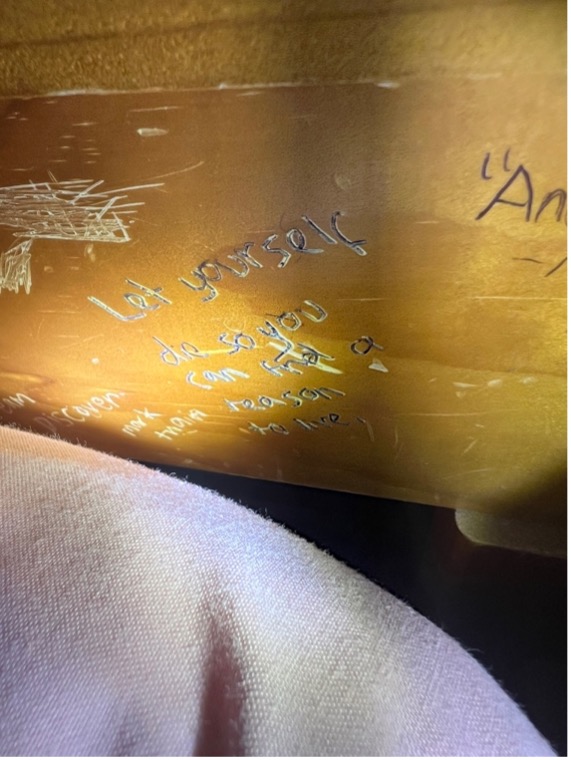
The first one I read, said “Let yourself die, so you can find a reason to live”.
Chills went all over my body, and because I was a Vipassana meditator, I felt every single chill in every single place! Like a whole-body reverberation!
And I cried.
This might sound a bit strange to some people reading (if anyone is still here in this abyss!), but I feel I’ve been in the process of dying for the past ~6-12 months. There’s been layers and layers of shedding of myself; parts that no longer belong and parts that I am reclaiming and bringing home; lost fragmented pieces of my soul that got left behind; coming back; re-integrating and entirely new pieces integrating for the first time. My first thought I just had was “this has felt violent”. And honestly, at times, it has. It has felt like being in that vortex ride at Dreamworld, where you put yourself up against the walls, and you stick to the wall, and the thing just spins around and around and around really fast. It finally stops, and everyone falls to the floor. And everyone gets up and walks around like they can’t get their footing, spinning still even though the spinning has stopped, walking sideways, can’t see up from down.
This is how the past year has felt.
I closed my nutrition and dietetic private practice in December 2022 after it running fairly successfully for the preceding 4 years. It was well established, grown to have a team, it was living on its own. I no longer had to work hard to have it known like I did in the early days. Despite this external success that appeared, I was deeply, truly burnt out.
And not just professionally, but burnt out on and in life itself; personally. Stepping back allowed a lot of room for many personal things from my life, past and present, that I had pushed deep below the surface to start coming up and bubbling to the surface in 2023. Moving through a lot of this has been really hard. Albeit, an important part of the process. And as it goes “what remains hidden, controls the life”, “our subconscious rules the life”. 2023 was about bringing those to light, and that isn’t always easy. Honestly it has been one of the hardest years of my life.
And so, as absolutely bizarre as it may sound, (& those who ‘get it’ likely won’t find it bizarre at all), at times it has felt like I’ve been dying. My partner has heard me describe it to him in this way many times over the past year and while he’s fairly open to my weird and wonderful ways of viewing life and death, and the depth of mind and matter that I regularly swim in, he hasn’t fully understood it although lovingly supports me anyway 😂
I have felt very lost; not knowing where to go or what to do. How to lean in to the process of death and rebirth when it feels so out of control.
And so, on day 5, after such a hard day, when a lot of ‘all of this’ was coming up, I read this quote, and I cried my heart out.
Not with pain or hurt, but with absolute trust and faith. Deeply knowing I’m not alone; we are never truly alone.
And maybe, I had to let myself die, so I could find a reason to live.
The next morning, I awoke to day 6 after a great sleep. A new spirit was within me. And I added this quote to the bed side dresser:
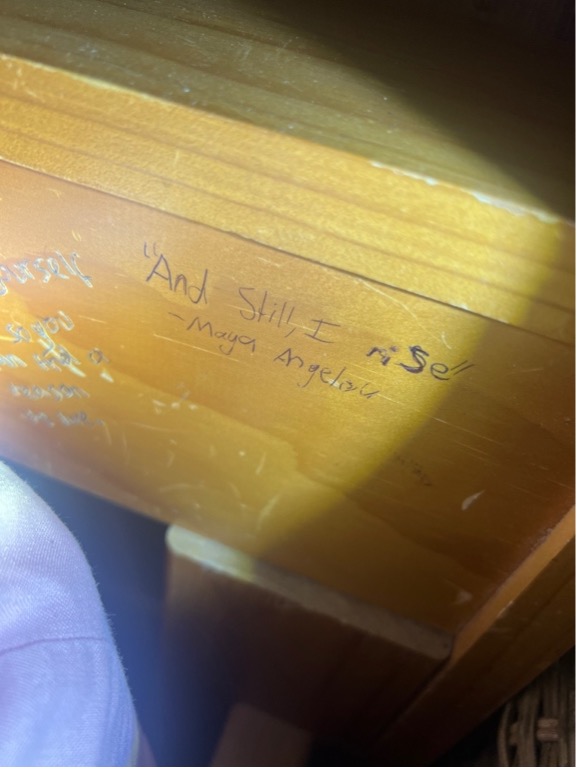
“And still, I rise” – Maya Angelou
The epiphany
Ok, so you don’t go to Vipassana to have epiphanies.
A lot of people say they want to come to a Vipassana course because they want to figure out “what do to next”.
For me, this Vipassana course was just about “being” and “existing”; and that was a pretty wonderful place to enter a course considering I don’t think I’d ever felt that way leading into a course.
There’s actually not a whole heap of time to “figure your life out”.
Not to mention, life isn’t something we have to ‘figure out’, right? It’s something that is here to live and be lived.
You’re at Vipassana to work hard, to work properly, learning the technique of Vipassana meditation, and how to “practise properly”.
However, sometimes without intentionality, people walk out of a course having clarity that their lives are on track with their values, and nothing needs to be shifted, and others walk out feeling like everything needs to be spun entirely on its head in order to re-align.
A notion I kept feeling time and time again, was:
“You’ve spent so much time exploring your inner world, it’s time to explore the outer world”.
I had this deep feeling of the push to travel.
To see the world.
“The world is given to you as a beautiful harden, you diminish the garden if you do not enjoy its fruits” – Dr Brian Weiss.
And it’s true, I really have spent a lot of time exploring my inner world. Digging deep down in the waters that exist within. Letting those tides sometimes roll over with such voluminous speed that it can feel like drowning, and other times a light wash that settles on the shoreline. For as long as I can remember, I’ve wanted to “know thyself, know thyself, know thyself’. While we have friends and family and even life partners that we learn about and know more about over the years, the most important person to truly ever know is yourself. That’s meant I’ve spent a lot of time with myself, with trying to understand my inner world.
And I had this strong feeling that arose maybe somewhere around halfway through the course that said, “enough of that Monique. You need to see the world”.
Like, a feeling that there is great power in knowing that a whole world exists beyond you. Beyond your little life, in your little town, with all the people you’ve always known and loved. A whole world exists out there. And you are a speck; a drop in that Universe.
Sometimes we need inner work, exploring, processing, support.
And for the first time I had this feeling that sometimes what we need is perspective; healing also happens when we see that life and this world is far, far greater than us, our histories, our traumas, our pains, our story, our relationships, our connections and disconnections.
I want to see people from all walks of life and explore cultures and hear people’s stories; the way people live on the ‘other side’. To laugh and cry and grow in a way I never really have.
Grow in joy, grow in beauty, grow in experience, grow in perspective.
“Exploring the world” seems cliché. But it’s actually never been something I’ve felt called to.
I love to travel in the times that I have, but it’s actually not something that has “set my heart on fire” like it seems to when I hear other people talk about it.
I’ve been fairly content with this life I’ve always known, with the comforts, with the things I know where they are, where they go, what the day looks like. “I know where all my little things go, in all their little places”.
So, for me, this actually wasn’t cliché at all; it was a pretty big and ‘unusual’ ‘epiphany’ (if I shall call it that!).
So, naturally, here I am, my second day home from Vipassana like “f**k, I’m gonna travel the f**king world!!!!!!!!!!”.
Anyone who has done a Vipassana course knows that deep feeling of invincibility that exists within your core after a Vipassana course, like “I can do anything” “the world is my mother f**king Oyster!”
I know that feeling will shift and morph in the coming days and weeks.
For now, I’m going to hold onto it a little bit longer.
Hopefully by keeping up my practice, that feeling may stay a little longer too.
I don’t really know what 2024 has in store. But I do know I want to see more of the world. Not the whole world as it’s pretty darn expansive. But maybe just a bit more of it than I’ve seen so far.
I don’t know how; really.
But I’ll let myself sink into this feeling for now, and take it as it comes.
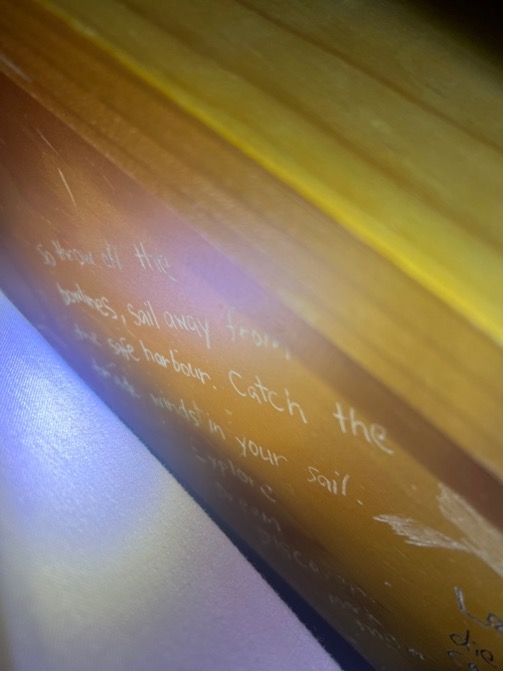
The last quote that was written on the bed side dresser by someone in a course before me was this. I saw it the same night that I saw the other quote. I read it after I’d read the first.
“So throw off the bowlines. Sail away from the safe harbour. Catch the trade winds in your sails. Explore. Dream. Discover” – Mark Twain
Let them come for the free food!
I love one of the stories Goenka tells in one of the nightly discourses.
When the movement of Vipassana started again in India by Goenka, sceptics would say something along these lines “what do you mean, you aren’t charging for these courses? People are going to be sceptical. No cost? You welcome people in for 10 days, they get a bed to sleep on, they get 3 meals a day. Most people in India are lucky to get one meal a day. People will be coming just for the free food you are offering”.
Goenka replied, something along these lines, “good, let them come, let them come for the free food. As long as they work hard, they work with the technique, they work properly, then let them come, let all the people come”.
Goenka just wanted people to experience the liberation from Vipassana. Let them come for free meals and let them leave changed forever. This is the ultimate act and existence of love and compassion.
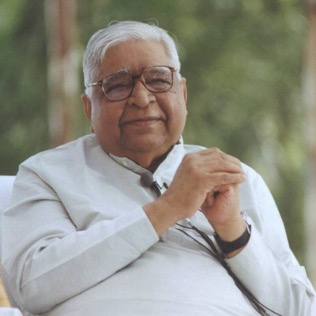

https://www.globalpagoda.org/sites/default/files/2010-07-Indian%20Express-Mum-Eng.pdf
If I had to describe a Vipassana 10-day course with a quote right now
“The ‘night sea journey’ is the journey into the parts of ourselves that are split off, disavowed, unknown, unwanted, cast out, and exiled to the various subterranean worlds of consciousness… The goal of this journey is to reunite us with ourselves. Such a homecoming can be surprisingly painful, even brutal. In order to undertake it, we must first agree to exile nothing.” – Stephen Cope




